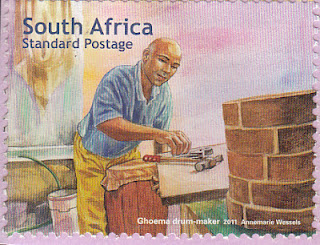Trochę się
poobijałam, ale dziś czeka mnie sporo pracy, dlatego na nogach
jestem od bladego świtu. Oj tak... z rzeczy bardziej przyjemnych
zeskanowałam swoje kartki na wymianę z UNESCO, a teraz
pieczołowicie zamierzam uzupełnić bloga. Niestety od 10.00
zaczynam przeprawę przez mękę: prasowanie, odkurzanie, składanie
pudeł i pakowanie w nie rzeczy do przeprowadzki. Pewnie koło 15:00
siądę w końcu do książek, a tu zbliża się nieubłaganie termin
egzaminów. No nic zaczynajmy! Maryś zachęciła mnie do
prezentacji kartek z dwóch kategorii zaczynam zatem od folkloru.
Zrobił się z tego niezły kopiec! Od czegoś jednak zawsze trzeba
zacząć. Poznajcie zatem Ndebele – grupę ludów zamieszkujących
między innymi Republikę Południowej Afryki. Ndebele należą do
plemion z grupy Nguni zupełnie jak Zulusi, trzeba jednak pamiętać,
że plemiona dzieli język, zwyczaje i obrzędy.
Dla Ndebele
wyjątkowe znaczenie ma tu sztuka, w tym dekoracje naścienne ich
domów. Te niesamowicie kolorowe i symetryczne wzory wykonywali
artyści bez jakichkolwiek „pomocy technicznych”. Ściany
własnych domów malują najczęściej kobiety, a ich kreatywność w
doborze kolorów i wzorów często określa ich status w grupie. Te
piękne pocztówki przysłała mi Ana wraz z jak zwykle ciepłą
wiadomością. Ach przypomniało mi się! Obręcze (dawniej z brąz)
wokół szyi, rąk i nóg oraz kolorowy strój to atrybuty dumnej
żony, a oznaczają jej oddanie dla meża.
English: I
would like to introduce you Ndebele. Although the origins of the
South African Ndebele are shrouded in mystery, they have been
identified as one of the Nguni tribes. The history of the Ndebele is
interesting but I will rather mention the customs related to the card
so... Ndebele women traditionally adorned themselves with a variety
of ornaments, each symbolising her status in society. After marriage,
dresses became increasingly elaborate and spectacular she also wears
copper and brass rings around her arms, legs and neck, symbolising
her bond and faithfulness to her husband, once her home was built. In
ealyer times she would only remove the rings after
husbands death. The rings (idzila) were believed to have strong
ritual powers. Husbands used to provide their wives with rings; the
richer the husband, the more rings the wife would wear.
The secound card is related to tribe
art that has always been an important identifying characteristic of
the Ndebele. Apart from its aesthetic appeal it has a cultural
significance that serves to reinforce the distinctive Ndebele
identity. Painting was done freehand, without prior layouts, although
the designs were planned beforehand. The characteristic symmetry,
proportion and straight edges of Ndebele decorations were done by
hand without the help of rulers and squares. Ndebele women were
responsible for painting the colourful and intricate patterns on the
walls of their houses. This presented the traditionally subordinate
wife with an opportunity to express her individuality and sense of
self-worth. Her innovativeness in the choice of colours and designs
set her apart from her peer group. In some instances, the women also
created sculptures to express themselves. Postcards were sent by Ana
my dear friend – Thank you!





Super kartka! Czyżby od TEJ Any? Też z nią regularnie koresponduję, i jest moją absolutnie ulubioną, ukochaną pen-card-palką!
OdpowiedzUsuńCieszę się, że zainspirowałam :D Folowe kartki są po prostu świetne, pokazują nieznane, ciekawe fragmenty świata.
A ja cieszę się, że mogłam sprawić komuś przyjemność :)
Usuń